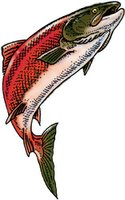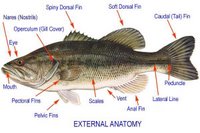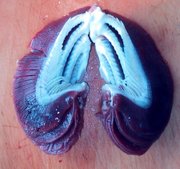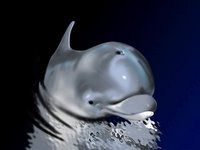 Sometime ago we looked at the question What happens to marine life when a lake or pond is frozen?. But have you ever wondered how fishes breathe in water much less to survive in a frozen pond or lake? Well, if this makes you ponder then read on. Water is the most abundant substance on earth that covers about 70 percent of the earth's surface. Thus, it is the home of various living organisms of which one such is fish. Water provides many functions that are essential to all known forms of life one of which is to provide a medium for aquatic animals to live and call their home. Such a home can be a; lake, pond, sea, river and stream just to name a few.
Sometime ago we looked at the question What happens to marine life when a lake or pond is frozen?. But have you ever wondered how fishes breathe in water much less to survive in a frozen pond or lake? Well, if this makes you ponder then read on. Water is the most abundant substance on earth that covers about 70 percent of the earth's surface. Thus, it is the home of various living organisms of which one such is fish. Water provides many functions that are essential to all known forms of life one of which is to provide a medium for aquatic animals to live and call their home. Such a home can be a; lake, pond, sea, river and stream just to name a few.What is a fish
Fish is any cold-blooded (poikilothermic) vertebrate animal that lives in water. It typically has jaws, fins, scales, a slender body, a two-chambered heart, and gills for providing oxygen to the blood. Thus, in simple terms, fish is a cold-blooded strictly aquatic vertebrate (animal with backbones) with gills. Fishes live in nearly every water habitat such as in fresh water like springs, swamps, lagoons, reservoirs, lakes and ponds and in salty water such as the ocean. They can be found in many climatic conditions from near-freezing Arctic waters to the hot desert springs.
Click image to enlarge
 Fish being an aquatic animal, has a respiratory system that is different from that of animals that live on land. It is capable of breathing under water without making frequent trips to the surface to breathe air like marine mammals such as the Whale (see discussion below for more details). This is due to the fact that fishes have a breathing organ known as gills. This is made up of thin feathery sheets of tissue membrane containing many blood vessels through which oxygen passes allowing fishes to breathe.
Fish being an aquatic animal, has a respiratory system that is different from that of animals that live on land. It is capable of breathing under water without making frequent trips to the surface to breathe air like marine mammals such as the Whale (see discussion below for more details). This is due to the fact that fishes have a breathing organ known as gills. This is made up of thin feathery sheets of tissue membrane containing many blood vessels through which oxygen passes allowing fishes to breathe.How fish breathe
The process begins by water in the fish’s surrounding entering its mouth‘s. Water enters the mouth by a very effective pumping system that involves the mouth and the outer flexible bony flap that cover the gills called the operculum. This is achieved by the opening and closing of the fish's mouth as it pumps water through the gills. When the fish’s mouth is open, the operculum closes and water is drawn into the fish’s mouth. Conversely, when the fish closes its mouth, the operculum opens and fresh water is then allowed to flow across the gills.
Click to enlarge image
 After water enters the fish's mouth it passes through a structure called the gill rakers. The
After water enters the fish's mouth it passes through a structure called the gill rakers. The function of the gill rakers is to act as a filter system by sieving out particles such as food or any other foreign particles that may have entered the mouth from the inflow of water. The filtered water then travel through the gill arches thus passing over the gills (see above diagram). Here each gill consists of two rows of extremely thin membranes called gill filaments. The structure of the gill filaments consist of sequence rows of a thin, disc-like membrane loaded with a capillary network called lamellae. Gill filaments which are projected out into the water flow allows water to flow across the lamellae. This will result in gas exchange where, oxygen and carbon dioxide are exchanged directly across the capillary membrane.
function of the gill rakers is to act as a filter system by sieving out particles such as food or any other foreign particles that may have entered the mouth from the inflow of water. The filtered water then travel through the gill arches thus passing over the gills (see above diagram). Here each gill consists of two rows of extremely thin membranes called gill filaments. The structure of the gill filaments consist of sequence rows of a thin, disc-like membrane loaded with a capillary network called lamellae. Gill filaments which are projected out into the water flow allows water to flow across the lamellae. This will result in gas exchange where, oxygen and carbon dioxide are exchanged directly across the capillary membrane.As water flows through the gills, the oxygen it contains (dissolved oxygen) passes into blood circulating through the gill structures (filaments and lamellae) while simultaneously, carbon dioxide ( the waste product) in the fish’s bloodstream passes into the water. This deoxygenated water is then carried away and out of the body through the operculum. This process repeats itself continually and this is the process by which fish breathe. This is process is also known as respiration.
Discussion:
Whales and dolphins are they fish?
Whales and dolphins are not fish. The definition of a fish is explained and defined in the above article. They are mammals just like humans and breath air using lungs, give birth to live young (rather than laying eggs), and feed their young with their mother's milk. Fish use their gills to extract oxygen from the surrounding water in which they live but mammals on the other hand ( such as humans , whales and dolphin) get the oxygen they need by breathing air, using their lungs. This explains why they come to the
 surface of the ocean. They have a hole (their nose) in the flat part of the middle of their heads called blow holes which closes when the whale or dolphin is under water and it opens when they are at the surface and need to breathe. The reason why warm-blooded animals like whales breath air like humans is due to the fact that it would be hard to extract enough oxygen from their water surrounding using gills. furthermore, air has approximately 20 times more oxygen in it when compared to the same volume of water. While on the other hand, fish being a cold-blooded animal take on the temperature of their surroundings and uses less energy than that of warm blooded animals which convert the food that they eat into energy to adjust their body temperature. This reduces oxygen demands for fishes thus, gills work best with fishes.
surface of the ocean. They have a hole (their nose) in the flat part of the middle of their heads called blow holes which closes when the whale or dolphin is under water and it opens when they are at the surface and need to breathe. The reason why warm-blooded animals like whales breath air like humans is due to the fact that it would be hard to extract enough oxygen from their water surrounding using gills. furthermore, air has approximately 20 times more oxygen in it when compared to the same volume of water. While on the other hand, fish being a cold-blooded animal take on the temperature of their surroundings and uses less energy than that of warm blooded animals which convert the food that they eat into energy to adjust their body temperature. This reduces oxygen demands for fishes thus, gills work best with fishes.What’s the purpose of fish nostrils?
It is important to note that although fish have nostrils they play no role in respiration but are rather used only for a sense of smell.
Why humans (mammals) don’t breath under water?
Most animals including humans had gills in their early fetal stage of development in the womb. However, they lost this organ further into their development since it has no essential function toward sustaining and maintaining live. Therefore animals, as well as, humans cannot breathe underwater because our lungs do not have enough surface area, that is necessary to absorb enough oxygen from water. Furthermore, the lining in our lungs is adapted to handle air rather than water. Fish on the other hand, retained these gills, which are necessary for their survival in their environment ( water medium ). Gills are very efficient at removing oxygen from water due to their feathery structure that greatly increases the surface area for gas exchange. Hence, gills play an important role in the anatomy of fish.
Where does the oxygen come from that the fish breathes?
 Water is formed from the combination reaction of hydrogen gas (H2) and oxygen gas (O2) to produce liquid water (H2O). In other words, each molecule of water is made up of two hydrogen atoms and one oxygen atom. However the oxygen that fish breath is not the oxygen found in H2O - the molecular formula of water. The oxygen in liquid water is bound to two hydrogen atoms forming water molecules, thus oxygen from is not free to take part in respiration. Therefore the fish cannot breathe the resulting liquid water, and the oxygen gas (O2) that the fish breaths comes from that which is dissolved in the water. Hence, fish "breathe" the dissolved oxygen out of the water using their gills. This also means that if there is not enough dissolved oxygen in the water, then the fish can suffocate, just as humans and other animals will if there is not enough oxygen in the air that we breathe.
Water is formed from the combination reaction of hydrogen gas (H2) and oxygen gas (O2) to produce liquid water (H2O). In other words, each molecule of water is made up of two hydrogen atoms and one oxygen atom. However the oxygen that fish breath is not the oxygen found in H2O - the molecular formula of water. The oxygen in liquid water is bound to two hydrogen atoms forming water molecules, thus oxygen from is not free to take part in respiration. Therefore the fish cannot breathe the resulting liquid water, and the oxygen gas (O2) that the fish breaths comes from that which is dissolved in the water. Hence, fish "breathe" the dissolved oxygen out of the water using their gills. This also means that if there is not enough dissolved oxygen in the water, then the fish can suffocate, just as humans and other animals will if there is not enough oxygen in the air that we breathe.Why some fish thrive in specific habitats?
This is due to the fact that some fish require more oxygen than others. This means that different aquatic environments, have different levels of dissolved oxygen content that suits some fish over others, due to the effective pumping system that extracts oxygen from its surrounding. Some fish have an effective pumping system that involves the mouth and the operculum however, their are some such as the tuna that have a much less effective pumping system and requires constant movement to keep oxygenated water flowing over their gills.
Other fishes deal with this by finding an ideal habitat. In northern streams the water is very cool thus resulting in the water retaining high levels of dissolved oxygen. An example of a fish that needs this high oxygen content is the trout. It is a very active fish and its demand for oxygen is high so the extra oxygen is a necessity. Conversely, warm water and stagnant water has much less dissolved oxygen content and fish with are not that active and have a slower metabolic rate strive well in these habitat. Carp is one such fish, their demand for oxygen is relatively low.
Did you know? - some interesting facts about fish.

- a scientist who studies fish is called an ichthyologist
- Fish are divided into three main groups: jawless fish, cartilaginous fish, and bony fish.
- A seahorse is actually a fish.
- The largest fish is the great whale shark which can reach fifty feet in length and weigh up to 15 tons.
- The smallest fish is the Philippine goby that is less than 1/3 of an inch when fully grown.
- The fastest fish is the sailfish. It can swims at more than 60 miles an hour.
- A walking catfish can live out of water for days at a time. They have a special chamber in their lungs to help them breathe.
- There are over 25,000 identified species of fish on the earth.
- There are more species of fish than all the species of amphibians, reptiles, birds and mammals combined.
- Some deep-sea fishes attract prey with specialized light organs.( e.g. Anglerfish)
- Most fishes sleep with their eyes open. Those that don't, rest by staying in one spot while not swimming around.
- Some fish like sharks don't posses an air bladder to help keep them afloat and must either swim continually or rest on the bottom.
- Some species of fish can fly (glide) others can skip along the surface and others can even climb rock.












No comments:
Post a Comment